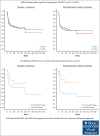MYC rearrangements in HIV-associated large B-cell lymphomas: EUROMYC, a European retrospective study
- PMID: 38207206
- PMCID: PMC10877133
- DOI: 10.1182/bloodadvances.2023010704
MYC rearrangements in HIV-associated large B-cell lymphomas: EUROMYC, a European retrospective study
Abstract
Large B-cell lymphoma (LBCL) carrying MYC rearrangement, alone or together with BCL2 and/or BCL6 translocations, have shown a poor prognosis when treated with rituximab plus cyclophosphamide, doxorubicin, vincristine, and prednisone (R-CHOP) in the HIV population. Scanty data are available on the prevalence and prognostic impact of MYC rearrangements in HIV-associated LBCL. We conducted a retrospective study to evaluate the clinical effect of MYC rearrangement in HIV-associated LBCL. We evaluated clinical characteristics, treatment received, and outcome of LBCL in patients with HIV with MYC rearrangement (MYC+) and without MYC rearrangement (MYC-). A total of 155 patients with HIV who had received fluorescence in situ hybridization analysis for MYC were enrolled in 11 European centers: 43 with MYC+ and 112 MYC-. Among patients with MYC, 10 had double-/triple-hit lymphomas, and 33 had isolated MYC rearrangement (single-hit lymphoma). Patients with MYC+ had more frequently advanced stage, >2 extranodal site at presentation, and higher proliferative index. There were no significant differences in overall survival and progression-free survival (PFS) between the 2 groups. However, patients with MYC+ received more frequently intensive chemotherapy (iCT) (44%) than (R)CHOP alone (35%) or infusional treatment (DA-EPOCH-R and R-CDE) (19%). Among patients with MYC+, those who received iCT achieved a better outcome than patients who received nonintensive treatment (complete remission, 84% vs 52%; P = .028; 5-year PFS, 66% vs 36%; P = .021). Our retrospective results suggest that HIV-associated LBCL with MYC+ could be considered for an intensive therapeutic approach whenever possible, whereas (R)CHOP seems to give inferior results in this subset of patients in terms of complete remission and PFS.
© 2024 by The American Society of Hematology. Licensed under Creative Commons Attribution-NonCommercial-NoDerivatives 4.0 International (CC BY-NC-ND 4.0), permitting only noncommercial, nonderivative use with attribution. All other rights reserved.
Conflict of interest statement
Conflict-of-interest disclosure: M.S. reports honoraria from Gilead, Servier, Novartis, Incyte, BeiGene, and Istituto Gentili; and research funding from Menarini. L.A. reports consultancy fees from or advisory role in Roche, Janssen-Cilag, Verastem, Incyte, EUSA Pharma, Celgene/Bristol Myers Squibb, Kite/Gilead, and ADC Therapeutics; speakers’ bureau fees from EUSA Pharma and Novartis; and research funding from Gilead Sciences. D.D. reports travel grants from Roche, Gentili, Lilly, and Eisai; and other remuneration from Gentili and Daikii Sanchio. The remaining authors declare no competing financial interests.
Figures




Similar articles
-
Dose-adjusted EPOCH-R (etoposide, prednisone, vincristine, cyclophosphamide, doxorubicin, and rituximab) in untreated aggressive diffuse large B-cell lymphoma with MYC rearrangement: a prospective, multicentre, single-arm phase 2 study.Lancet Haematol. 2018 Dec;5(12):e609-e617. doi: 10.1016/S2352-3026(18)30177-7. Lancet Haematol. 2018. PMID: 30501868 Free PMC article. Clinical Trial.
-
Inferior survival in high-grade B-cell lymphoma with MYC and BCL2 and/or BCL6 rearrangements is not associated with MYC/IG gene rearrangements.Haematologica. 2018 Nov;103(11):1899-1907. doi: 10.3324/haematol.2018.190157. Epub 2018 Jun 14. Haematologica. 2018. PMID: 29903764 Free PMC article.
-
MYC expression in concert with BCL2 and BCL6 expression predicts outcome in Chinese patients with diffuse large B-cell lymphoma, not otherwise specified.PLoS One. 2014 Aug 4;9(8):e104068. doi: 10.1371/journal.pone.0104068. eCollection 2014. PLoS One. 2014. PMID: 25090026 Free PMC article.
-
Diffuse large B-cell lymphoma with MYC gene rearrangements: Current perspective on treatment of diffuse large B-cell lymphoma with MYC gene rearrangements; case series and review of the literature.Eur J Cancer. 2016 Mar;55:140-6. doi: 10.1016/j.ejca.2015.12.001. Epub 2016 Jan 25. Eur J Cancer. 2016. PMID: 26820684 Review.
-
The Spectrum of MYC Alterations in Diffuse Large B-Cell Lymphoma.Acta Haematol. 2020;143(6):520-528. doi: 10.1159/000505892. Epub 2020 Feb 19. Acta Haematol. 2020. PMID: 32074595 Review.
Cited by
-
Human immunodeficiency virus-associated Lymphomas: EHA-ESMO Clinical Practice Guideline for diagnosis, treatment and follow-up.Hemasphere. 2024 Sep 3;8(9):e150. doi: 10.1002/hem3.150. eCollection 2024 Sep. Hemasphere. 2024. PMID: 39233903 Free PMC article.
-
Molecular and clinical insights into HIV-associated and HIV-negative aggressive B-cell lymphomas: prognostic quantitative biomarker analysis and therapeutic implications.Front Oncol. 2025 May 27;15:1603801. doi: 10.3389/fonc.2025.1603801. eCollection 2025. Front Oncol. 2025. PMID: 40496610 Free PMC article.
-
Lymphoproliferations in People Living with HIV: Oncogenic Pathways, Diagnostic Challenges, and New Therapeutic Opportunities.Cancers (Basel). 2025 Jun 22;17(13):2088. doi: 10.3390/cancers17132088. Cancers (Basel). 2025. PMID: 40647389 Free PMC article. Review.
References
-
- Swerdlow SH, Campo E, Harris NL, et al. IARC Press; 2017. WHO classification of tumors of Haematopoietic and Lymphoid Tissues.
-
- Landsburg DJ, Nasta SD, Svoboda J, Morrissette JJ, Schuster SJ. 'Double-Hit' cytogenetic status may not be predicted by baseline clinicopathological characteristics and is highly associated with overall survival in B cell lymphoma patients. Br J Haematol. 2014;166(3):369–374. - PubMed
-
- Li S, Desai P, Lin P, et al. MYC/BCL6 double-hit lymphoma (DHL): a tumour associated with an aggressive clinical course and poor prognosis. Histopatology. 2016;68(7):1090–1098. - PubMed
Publication types
MeSH terms
Substances
LinkOut - more resources
Full Text Sources
Medical
Research Materials

